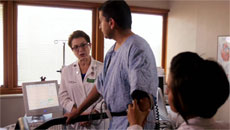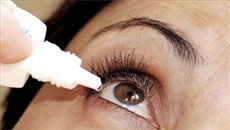I had the opportunity to sit down with Dr. Amit Mathur and discuss eye care issues and why he is so dedicated in raising awareness of eye care in the South Asian population. Dr. Mathur has been practicing primarily in North Vancouver and Burnaby for over a decade. He was the top graduating student from the only English instruction Optometry school in Waterloo, Ontario.
He has worked in a busy laser vision centre and is advisor to pharmaceutical companies with eye products for dry eyes, allergy drops, antibiotics like Alcon and Novartis with focus on supplements to treat macular degeneration. “Being South Asian myself I am privileged to assist a lot of patients from the Indian subcontinent. As we immigrate to Canada, many aren’t aware of preventative measures that are available to them. So many eye care problems are treatable and more importantly preventable, with routine eye examinations and timely care – especially important in children.
Eye exams are still in BC funded annually for children and seniors and for those that have eye diseases – yet as an ethnic group, South Asians are not aware of these benefits and or still do not take the preventative measures available as much.”
From our last issue on eye care, we received some great feedback from our readers. The first most common inquiry was more information on the common causes for ongoing red eyes and having the feeling of something in the eye, the need to rub the eyes a lot, or having watery eyes.
The symptoms above can be present in infections from viruses and bacteria, but these are more rare, and happen all of sudden rather than being present for weeks or months, and sometimes years. The more common reason for symptoms like those mentioned above – having red eyes, feeling like something is in the eye (foreign body sensation), and the sensation of burning is referred to ocular surface disease. Dry eye disease is also a term used interchangeably, and this is a very very common problem in South Asians.

In this dry eye disease, somehow there is a lack of tears, or poor quality of tears available to cover and protect the clear window of the eye called the cornea. The cornea has lots of nerves and is an extremely sensitive tissue, so when it is not protected by a healthy tear layer, the nerves are quick to respond with the symptoms of irritation, foreign body sensation, short pin pricking pains and heaviness of the lids.
In fact, in response to these irritations, and in an effort to fix the lack of tears the eyes can be seen as actually “watery”. This situation seems contradicting, but the problem is usually dryness of the cornea, and the constant watery tears the eye make in response are not the same or from the same tears ducts that are required on the cornea. So when our eyes water in the wind, cold, in air conditioning or when we sit in front of the heat vents in a car, this is actually a signal of dry eye disease!
Dry eye disease is actually an inflammation of the ocular surface, it causes the irritating symptoms above and actually causes vision blurriness and should be managed/treated early before it gets to be truly debilitating. Eye doctors when examining the eyes have to determine which of the 3 layers of the tears are aberrant or deficient in the eyes, and then determine the proper course of treatment.

It is important to note that not all dry eye disease is treated with the same drops or medication – it depends on the specific cause. For instance, the most common cause of dry eye disease is due to the “watery” layer of the tears being too thin. The tear ducts themselves can be the problem, diseases like rheumatoid arthritis and some general body diseases can contribute to this problem, and medications we take can also cause the dry eyes. Medications that treat high blood pressure, depression, and allergies are common culprits, yet so commonly used in the public.
Another common type of deficiency that leads to dry eye disease results from tear ducts along the lashes of the top and bottom lids being blocked, narrowed, or damaged – meibomian gland dysfunction. The eye doctor can look and see the tear ducts being defective. In some people more styes and lid inflammations are common and the quality of the tears is poor and the dry cornea results from evaporation of the tears.

Treatment of the aqueous deficient or the first type of dry eye disease I described (where there is less water in the tears produced) includes using artificial tears to cover the cornea and act like bandages over the dry areas of the front of the eye. The goal is to try to find a drop that makes the eye feel better without needing to put them in the eyes several times a day, and helps repair the dry damaged cells of the cornea. I find the drops called Systane Ultra to be very helpful in these cases, using humidifiers at the office and bedroom, and sometimes thicker ointments or Systane Gel drops at night. People at work during the day find putting in drops a hassle or a bother, but some drops like the Systane Ultra do not interfere with vision and treat the dry eyes – so patients will use the drops properly and routinely.
Dry eye disease is an inflammation, usually been chronic, so it takes time for the drops to be beneficial. In more severe cases, the inflammation commonly is treated with steroid anti-inflammatory drops which are very effective and also with prescription eye drops now available in Canada called Restasis. These used over time try to increase your own eyes tear production. In treating these severe cases since the drops were made available early last year I have found great success in alleviating patients’ symptoms.
In the second common type of dry eye disease where the small tear ducts along the lids of the eyes are affected (meibomian gland dysfunction) drops that replenish an oily component of the eye’s tears are more effective, such as Systane Balance eye drops. Applying heat directly on the lid margins (usually by a steam hot face towel over closed eyes) will help unclog the blocked tears ducts, and taking omega 3 pills and some antibiotic pills can also help in the production of better tears.
In our practices we find the cases of dry eye disease are greater in the South Asian population. This may arise from lots of sun exposure, UV, being brought up in sunnier countries and lack of sunglass useage. We find this causes changes in the white parts of the eyes, and can increase blood vessel growth onto the cornea of the eyes and cause irritation.
Also, many times in our seniors that grew up in rural communities in countries of the Indian subcontinent or Africa contaminations of water or infections related hygiene as children result in scarring and damaged cells of the cornea yet again. When the cornea cells are unhealthy, the top layer of cells from the cornea can slough off easily also leading to more corneal disorders called dystrophies which also increase the dry eye disease. In South Indians the cases of heart disease and high blood pressure are very high, and it is well known that many classes of medications to treat these diseases also can cause dry eyes.
Dry eye disease is one of the more common causes of red irritated eyes that does require evaluation and treatment and can be managed successfully – see your eye doctors routinely.
What’s new in eyeglasses lens?

To most people, eyeglass lenses look much the same today as they did when they started wearing first years ago. But technologies evolve rapidly and now might be a good time to ask your Eyecare Professional what has changed since you got your last pair! All eyeglass lenses seem to me to be the same.
How do I know that they are more advanced, and that they are right for me?
Your Eyecare Professional, will be able to discuss new products and will find out about your needs, and take into account your prescripton. Lenses may all have the same prescription, but can differ in their material (polycarbonate, plastic, glass), thinness or index, amount of light free of distortion, Abbe value, and how they are manufactured to remove imperfections possibly leading light scatter, the quality of anti-reflection coatings.
I have problems with fog on my lenses when I go jogging and when the temperature is colder and I go from outside to inside. It is very annoying, and sometimes makes me feel unsafe. Is there a solution for that?
Fog on the lens is a commonplace phenomenon, but only recently did the lens manufacturer Essilor release a solution – Optifog™ lenses that provide efficient and durable fog-free vision. They are suitable for individuals with all types of vision correction needs, and can be adapted according to different styles, fashion and personal tastes. This technologically advanced combination provides incredible scratch, glare and dust protection as well as the most effective and durable anti-fog solution on the market.
My child is nearsighted (difficulty seeing far). Is there anyway to prevent the nearsightedness from increasing?
Your child is affected with myopia, which can create visual problems and impact on academic results and limit career choices. There are some hard lenses worn at night that try to reshape the eye to slow nearsighted progression called ortho-K on the market, and now some lenses in glasses that try to slow nearsighted progression. One company Essilor has created Myopilux Max and Myopilux Pro, two categories of lenses that slow down the progression of myopia in children.
Myopilux Max is the most effective way to control myopia: it slows down its progression up to 62%. The benefits of Myopilux Max were validated in a study conducted in Canada by Dr Desmond Cheng from Waterloo University. A 2 years efficacy study conducted amongst 87 Chinese children showed progression of myopia to be slowed down by up to 62%* between the age of 7 – 13.
Myopilux Pro is an effective solution to slow down the progression of myopia in children up to 38% when they have an eye tendency to cross inwards.
What about UV protection? Are there lenses that offer more protection than others?
You are right to worry about UV exposure. It is a major cause of ageing for the eyes and a cause for the accelerated appearance of cataracts, implicated in a retinal disease called macular degeneration, can lead to yellow growths on the white part of the eyes. UV is present all year long and can badly damage your eyes.
The first level of UV exposure comes from light passing through the front of the lens. Clear lens materials cut 95% to 100% of the front UV rays. However, the biggest remaining UV exposure comes from the back & sides to hit rear lens surface and reflect in the eye. Essilor just released a new generation of Crizal no-glare lens with a backside UV protector. Crizal UV lenses provide an eye-sun protection factor (E-SPF) of 25, the most complete protection for your eyes. Other options to protect the eyes are simple from wearing brimmed hats, transitions or photochromic lenses, sunglasses or prescription sunglasses and clip-ons even.
The Importance of Regular Eye Exams for Children

In this month’s issue, we are highlighting the importance of regular eye examinations for children. We have the priviledge of medical care that covers regular eye examinations for children, therefore why is it that many children are still diagnosed with amblyopia or get glasses only when they start complaining of headaches and/or blurry vision at distance. Vision to a growing child is of utmost importance; it can affect their grades in school, their development socially with other children and also the physical strain that the lack of prescription can put on their visual system. As eyecare professionals, we need to address the prescription changes as needed for our growing population of children however more importantly we need to ensure that amblyopia does not develop in our patients.
What is AMBLYOPIA (commonly known as lazy eye) ……………?
According to many literature studies done over the past years, amblyopia continues to be the most common cause of visual impairment in childhood. Currently, the condition affects approximately 2-3% of children with the prevalence of undetected vision problems such as amblyopia, strabismus, and errors of refraction in preschool children estimated at in 5. Howeve,r if you ask most eye-care professionals about the amount of amblyopia alone in their practice would be about 10-15% of examined children.
How do we see ?
Simply put, our eyes capture an image on our retina and relay it to our brain through our optic nerve. Light enters the eye and is changed into nerve signals that travel along the optic nerve to the brain. The optic nerve is essentially the wiring that captures the image from the retina and relays it to our brain. Amblyopia, put simply, affects the relay system between our wiring (optic nerve) and the brain. It’s a medical term used when the vision in one eye is reduced because the eye and the brain are not working together properly.
The eye itself looks normal, but it is not being used normally because the brain is favoring the other eye. There is a critical period in which amblyopia develops and this is usually between birth and 6 years of age. Amblyopia developing after 6 years of age is usually harder to treat and results vary in vision gained. In amblyopia, there is one weaker eye, and not matter what prescription glasses, contacts, or laser surgery you do, it doesn’t see as good as the other eye.
What causes Amblyopia …..?
This can be due to a variety of causes. Firstly, it can be caused by strabismus, an imbalance in the position of the two eyes. Strabismus can cause the eyes to cross in (esotropia) or turn out (exotropia). When this happens, the eye that is turned in or out does not have a clear image on the retina due to the eye turn. Due to this, the optic nerve (wiring) can be hindered and may not develop as well as we would want it to.
In situations like this, if the eye turn is left uncorrected, as the child gets older, the optic nerve in that eye is not as developed as the optic nerve in the other eye which means that the child has a HIGH risk of never being able to see as clear in that eye. Therefore when the child turns older, he/she may never be able to see 20/20 in that eye despite eyeglasses or contacts. This can also affect their depth perception; many of them are unable to appreciate 3D movies. As the child gets older, he/she starts favouring the good eye and not using the bad eye which, as years go on, causes them to really only be using the good eye and SUPPRESSING( not using) the vision in the bad eye. Therefore as the condition persists, the weaker eye essentially becomes useless.
Secondly, it can be caused when one eye is more nearsighted,farsighted or astigmatic than the other eye. This happens frequently in our practice. Lets consider this situation. A 6 year old in kindergarten has not seen an eye doctor for any exams. When asked by his parents’ how his vision is doing, he replies “ no problems”. The kid sits with his parents’ in the car and they ask him questions about what he can see on the road and he seems to be seeing just as good as his parents’ or even better. With both eyes open the kid sees 20/20.
The same kid comes into our office and we term him as having a lazy eye. With BOTH eyes open he sees 20/20, his right eye does not have a prescription but is left eye has a high prescription; if not corrected in his left eye the child will most likely be using his right eye for the rest of his life with his left eye lagging behind. The JEST of this example is that , YOU, the parent will not be able to determine if your child is amblyopic, that is something that we need to look at in regular eye examinations for kids.
BUT, my kid’s school does vision screening for all kids. They will be able to find out if the child is amblyopic right ??????
Vision screenings are done in many schools in BC however due to lack of government funding for schools has caused some of these programs to not be as prevalent as before. Most visual screenings are done by a nurse with a chart located at distance in a room. Visual screenings are only that, “screenings” they help determine which children may need a “FURTHER EXAMINATION” and by no means are a full complete eye examination.
Children need to be seen by a certified optometrist for a full visual examination to determine amblyopia and its extent. Most of the equipment that is needed for an full eye examination is not portable therefore, having your children come in for an exam in a clinic is the best way to care of their vision needs.
What Treatments are available……??
The first step in correcting amblyopia is to ensure that the child has the proper prescription needed for their eyes; glasses are frequently prescribed to improve the focussing or misalignment of the eyes. In more advance cases of an eye turn, surgery may be performed on the eye muscles to straighten the eyes if non-surgical means are unsuccessful. Surgery can help amblyopia by allowing the eyes to work together better. In addition, eye exercises may be recommended either before or after surgery to correct faulty visual habits due to the eye-turns and to teach comfortable use of the eyes. Prescribing eye exercises for the eye muscles is just like working out other muscles in your body. We target the “weakened muscle” and train the muscle as if we were doing physiotherapy of the muscles of the eyes.
Once the underlying cause of the amblyopia is established and we have introduced the right prescription for the child, we can move on to patching of the eyes if needed. With “patching” we use a patch over the child’s good eye, forcing the bad eye to work. This treatment modality has proven to be effective in helping correct amblyopia in children. If the physical patching of the kids’ eyes is tough to do there then rarely medicated drops t can be used to blur out the good eye forcing the child to use their bad eye again.
When should I bring my children in for eye exams ?
The Governing Council of the American Public Health Association policy states that “early comprehensive childhood eye care is often neglected and that less than half of pediatricians perform even limited vision screenings often limited to a single light reflex test” (6). The Council suggests that parents and their physicians be encouraged to seek regular comprehensive eye examinations at six months, two years and four years of age. The National Child Development Study, “From Birth to Seven: A Report of the National Children’s Bureau” (12), followed a population of 17,000 children born during the first week of March 1958, for seven years. They found that more children have defective vision than any other defect, excluding dental disease.
One of the reasons why screening exams for children are so important is that there is a CRITICAL PERIOD in the development of children that lasts between birth and 6 years of age. According to literature, it is harder to correct amblyopia when children are above the critical period of 6 years. Therefore, it is essential to bring your children in for eye examinations yearly. Once we get past the critical period, it is harder for us as eye doctors to correct amblyopia.
How can Amblyopia affect my child and his/her development….. ?
If amblyopia is left untreated, it can cause many different issues for the child and his/her development thereafter. Due to underdevelopment of the child’s depth perception for example, judging distances and driving can be hard; occupations such as police officers, electricians and long-haul truck drivers require a certain level of depth perception ad so amblyopia can affect a child’s career choices.
An eye-turn can be a hard issue for a child to deal with at school. Other children may treat the child differently due to their physical and cosmetic eye-turn. This can cause the child to lead a more sheltered life, affect self esteem. They may spend more time with computers and books and not develop socially with other children at school.
Grades at school can definitely be affected. Having only one eye seeing while at school places a lot of stress on the good eye; this can in turn lead to headache, slower reading speed and fluency and focussing problems which can reduce the capability of the student. In our practice, we have seen struggling students become A students just from addressing their vision needs.






